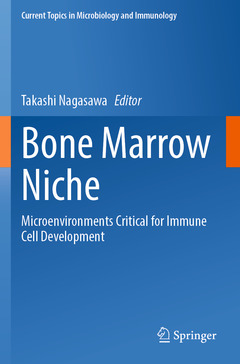Description
Bone Marrow Niche, 1st ed. 2021
Microenvironments Critical for Immune Cell Development
Current Topics in Microbiology and Immunology Series, Vol. 434
Coordinator: Nagasawa Takashi
Language: English
Subjects for Bone Marrow Niche:
Publication date: 11-2022
134 p. · 15.5x23.5 cm · Paperback
Publication date: 11-2021
134 p. · 15.5x23.5 cm · Hardback
Description
/li>Contents
/li>Biography
/li>Comment
/li>
This volume summarizes recent advances in research on mesenchymal cell populations in the bone marrow. It explores how mesenchymal cells create niches for immune cells in extramedullary organs and it discusses new concepts of lympho-hematopoietic microenvironments. Readers are introduced to the fundamentals of hematopoietic stem cells (HSCs) differentiation to all types of blood cells, including immune cells, in the bone marrow. The book highlights how this process is supported and regulated by the individual microenvironments of stem cells, termed niches.
The identity of HSC niches has been subject to longstanding debates. Recent studies identified the population of mesenchymal stem cells as the major cellular component of niches, for hematopoietic stem and progenitor cells (HSPCs) and their candidate developmental origin. Furthermore, candidate cellular niches for immune cells in lymph nodes and adipose and connective tissues were identified. The authors of this volume focus on shared features between those and HSPC niche cells in the bone marrow.
Covering latest research results, this book serves as fascinating read for researchers and clinicians in hematology and immunology.
1) Charles KF Chan (chazchan@stanford.edu; Stanford University, USA)
Skeletal stem cells as the developmental origin of cellular niches for hematopoietic stem and progenitor cells (HSPCs)
2) Takashi Nagasawa (tnagasa@fbs.osaka-u.ac.jp; Osaka University , Japan)
Cellular niches for maintenance of HSPCs in adult bone marrow during homeostasis and blood cancers
3) Cesar Nombela-Arrieta (Cesar.NombelaArrieta@usz.ch; University Zurich, Switzerland)
Effects of inflammation and infection in the niches for HSPCs and immune cells
The role of interleukins, including IL-7 and IL-15 in the niches for HSPCs and immune cells
5) Tomoya Katakai (ikuta.koichi.6c@kyoto-u.ac.jp; Niigata University, Japan)
Cellular niches for maintenance and regulation of immune cells in lymph nodes
6) Yasutaka Okabe (okabe.yasutaka.6z@kyoto-u.ac.jp; Kyoto University, Japan)
Cellular niches for maintenance and regulation of immune cells in adipose and connective tissues
Illustrates the complete organization of complex bone marrow microenvironments
Explains how mesenchymal cells maintain and regulate hematopoietic stem and progenitor cells
Provides a unique perspective on origin and functions of mesenchymal cells
These books may interest you

Hematopoietic Stem Cell Niche 143.27 €

The Cancer Stem Cell Niche 143.27 €


